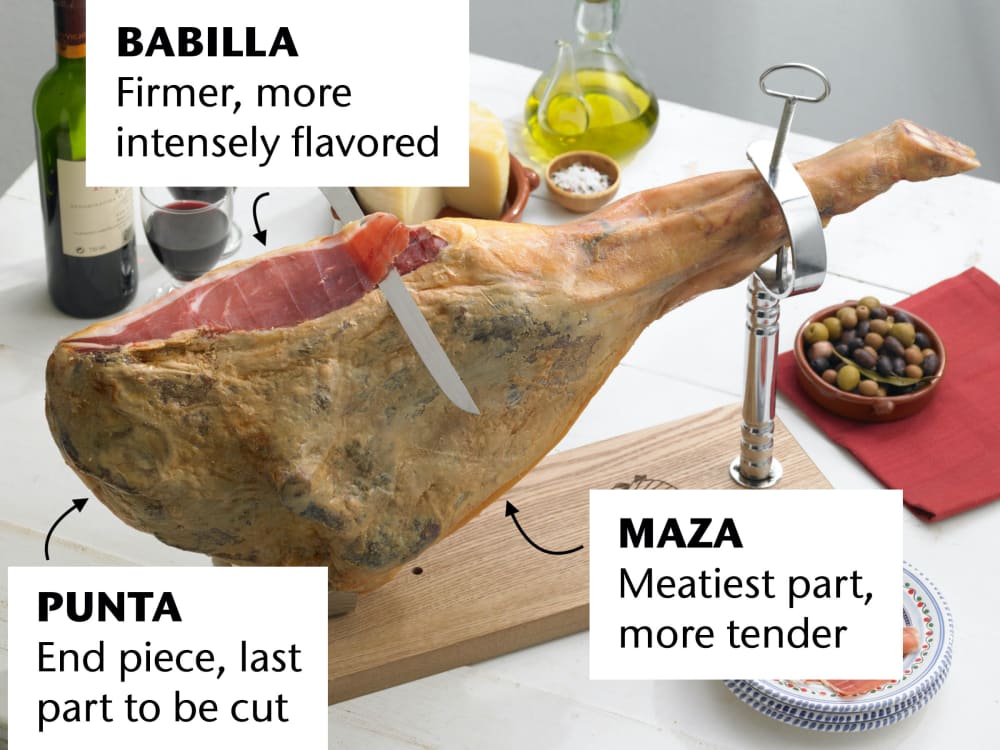How to Slice and Store Jamón
January 2010




Jamón is the culinary treasure of Spain. Spaniards enjoy more ham per person than anyone in the world. A whole jamón can be stored in your kitchen and used daily as tapas or in recipes. It is also a great conversation piece for parties and holiday gatherings.
Slicing Spanish Ham
To enjoy the flavor and authentic texture of a fine jamón, slice the ham with a long sharp knife in the following order: first the rump half (maza) which has the most meat and is the most tender, then the rump end (babilla) which is firmer and more cured, and lastly the end (punta). We recommend starting with the babilla since the maza will stay moist longer. Some parts of the ham will be much firmer and more intensely flavored than others depending on the thickness of the meat.
Remove the layer of fat from the top and the sides until the meat is exposed. Trim the fat as you slice. Cut small, very thin slices. Slice downwards with your free hand behind the knife.
Below is a video we made showing the proper method of carving a jamón.
Storage
Bone-In Jamón: Store your whole bone-in ham in the refrigerator in its original packaging for 2-3 months or until the best-by date. A day or two prior to cutting into your jamón, remove from the plastic packaging and store it uncut at room temperature on a ham holder or hang from the rope provided. Harmless white mold on the exterior of whole cured hams is not uncommon and can be wiped off using a cloth and some olive oil.
Once you have started slicing into it, the ham can be kept in a cool, dark place on a ham holder for 6 to 8 weeks. Cover the cut surface with reserved fat from the ham, and drape with plastic wrap and a light breathable cloth. Only cut into sections of your ham you plan to carve and eat within a few days. Do not remove skin or fat from other areas. Chunks of ham may be stored tightly wrapped in the refrigerator or freezer for longer term storage.
Boneless or Center Cut Jamón: Store your boneless or center cut ham in the refrigerator. For easier slicing with an electric slicer or ham knife, place the ham in the freezer for 20 minutes prior to slicing. Leftover pieces can be wrapped tightly in plastic and stored in the refrigerator or freezer for longer term storage.
Sliced Jamón: Your sliced jamón should be stored according to the package instructions. Serve slices at room temperature. Keep leftover slices refrigerated in an airtight container and consume within 3 to 5 days
Jamón Appearance
Mold: A thin layer of mold may appear on whole hams. This penicillin-like mold is completely harmless. It can be removed with a clean, damp cloth or with a cloth and olive oil.
Small white spots: These are small "chalky" granules that form between the muscle fibers during the curing process. They vary in shape, size and location. They are amino acids found in aged meat and cheese products and are perfectly safe to eat.
Iridescent coloring: This coloring can be seen on the cut surface of the ham and in certain parts of the meat. It is insignificant as far as the quality of the ham is concerned.
Salt: Sometimes salt can crystallize on the surface of the ham in dry conditions. This inorganic salt does not affect the flavor of jamón and can be brushed or wiped away.
White film: This may be seen on the cut surface of whole or boneless hams. Simply slice off the section with the film and discard the discolored slice.
Fat: Whole hams are covered with a thick layer of fat, which protects the meat and helps it keep longer. Some areas are much dryer than others, and each part of the ham has a different texture and flavor.
Related Articles

